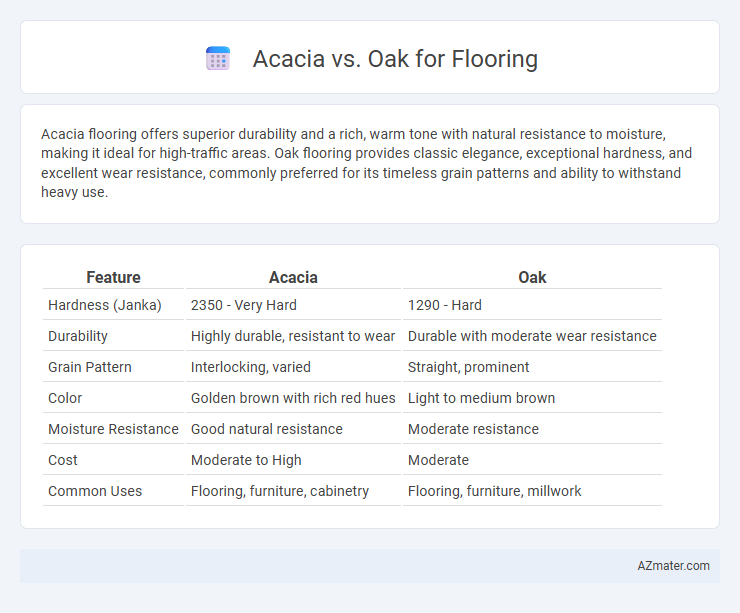Acacia flooring offers superior durability and a rich, warm tone with natural resistance to moisture, making it ideal for high-traffic areas. Oak flooring provides classic elegance, exceptional hardness, and excellent wear resistance, commonly preferred for its timeless grain patterns and ability to withstand heavy use.
Table of Comparison
| Feature | Acacia | Oak |
|---|---|---|
| Hardness (Janka) | 2350 - Very Hard | 1290 - Hard |
| Durability | Highly durable, resistant to wear | Durable with moderate wear resistance |
| Grain Pattern | Interlocking, varied | Straight, prominent |
| Color | Golden brown with rich red hues | Light to medium brown |
| Moisture Resistance | Good natural resistance | Moderate resistance |
| Cost | Moderate to High | Moderate |
| Common Uses | Flooring, furniture, cabinetry | Flooring, furniture, millwork |
Introduction: Comparing Acacia and Oak Flooring
Acacia flooring offers a unique blend of durability and exotic hardwood appeal, characterized by rich color variations and natural resistance to wear. Oak flooring, widely favored for its classic grain patterns and strength, provides a timeless and versatile option suitable for various interior styles. Both woods deliver long-lasting performance, but Acacia tends to be harder and more moisture-resistant, while Oak offers more traditional aesthetics and easier maintenance.
Origin and Characteristics of Acacia Wood
Acacia wood originates primarily from Australia and Southeast Asia, known for its rich golden to reddish-brown hues and natural luster. It is a highly dense and durable hardwood, resistant to scratches and dents, making it ideal for flooring in high-traffic areas. Acacia's unique grain patterns and natural oils contribute to its enhanced resistance to moisture and decay compared to traditional oak flooring.
Overview of Oak Wood Flooring
Oak wood flooring is renowned for its durability, attractive grain patterns, and versatile color range, making it a popular choice for both traditional and modern interiors. Its high hardness rating, typically around 1290 on the Janka scale, ensures excellent resistance to dents and scratches, suitable for high-traffic areas. Oak floors also offer superior stability and can be finished in various stains, enhancing natural warmth and character over time.
Durability and Hardness: Acacia vs Oak
Acacia flooring boasts a Janka hardness rating of approximately 1,700, making it notably harder and more resistant to dents than traditional oak, which ranges from 1,200 to 1,360 depending on the species. The dense grain structure of acacia provides superior durability, suited for high-traffic areas and homes with pets or children. Oak, while slightly softer, offers excellent wear resistance and is easier to refinish, maintaining a balance of hardness and traditional durability for flooring needs.
Appearance and Grain Patterns
Acacia flooring features rich, dark hues with striking contrast and bold grain patterns that create a rustic yet elegant aesthetic, making each plank unique. Oak flooring, in comparison, displays a lighter, more uniform color palette with subtle grain variations, offering a classic and timeless look suitable for various design styles. The pronounced swirling and knotty grains of Acacia add character, while oak's straight, consistent grain provides a smoother, more traditional visual appeal.
Color Variations and Finishes
Acacia flooring offers rich color variations ranging from golden amber to deep reddish-brown with striking natural grain patterns, while oak flooring presents a more uniform palette of light tan to medium brown hues with subtle grain texture. Acacia is well-suited for high-gloss and hand-scraped finishes that enhance its dramatic color contrasts, whereas oak commonly features matte, satin, or distressed finishes that emphasize its classic, timeless appeal. Both hardwoods allow for versatile staining options, but acacia's vibrant natural colors reduce the need for heavy staining compared to oak.
Maintenance and Longevity
Acacia flooring offers superior hardness and natural resistance to scratches and dents, requiring minimal maintenance with regular sweeping and occasional damp mopping to preserve its appearance. Oak flooring, renowned for its durability and traditional grain patterns, demands periodic refinishing every 7-10 years to maintain its longevity and can tolerate higher foot traffic with proper care. Both species boast long lifespans exceeding 50 years when adequately maintained, but Acacia's denser structure provides enhanced resistance to wear and moisture-related issues.
Environmental Impact and Sustainability
Acacia flooring is considered more sustainable due to its rapid growth rate and ability to thrive in diverse climates, which reduces deforestation pressure. Oak, while durable and long-lasting, typically grows slower, leading to concerns about longer replenishment cycles and habitat disruption. Choosing acacia supports better carbon sequestration and less environmental degradation compared to traditional oak harvesting practices.
Cost Comparison: Acacia vs Oak Flooring
Acacia flooring generally costs between $5 to $8 per square foot, making it more affordable than oak, which ranges from $6 to $12 per square foot depending on the quality and grade. The installation expenses for both hardwood types are similar, but acacia's faster growth rate often translates to better pricing and availability. Oak tends to hold a higher resale value due to its popularity and durability, potentially offsetting its higher initial cost.
Which to Choose: Acacia or Oak for Your Home?
Acacia flooring offers a rich, exotic look with high durability and natural resistance to moisture, making it ideal for high-traffic and humid areas. Oak flooring, available in red and white varieties, provides classic aesthetics with strong hardness and excellent wear resistance, suited for traditional and timeless interior styles. Choose Acacia for bold, unique grains and resilience in moisture-prone rooms, or Oak for proven strength and versatile design compatibility in most living spaces.

Infographic: Acacia vs Oak for Flooring
 azmater.com
azmater.com